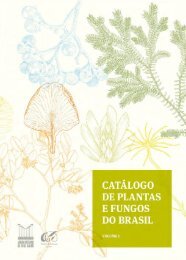A TAXONOMIC REVISION OF HYMENOPHYLLACEAE
A TAXONOMIC REVISION OF HYMENOPHYLLACEAE
A TAXONOMIC REVISION OF HYMENOPHYLLACEAE
You also want an ePaper? Increase the reach of your titles
YUMPU automatically turns print PDFs into web optimized ePapers that Google loves.
6<br />
BLUMEA — Vol. 51, No. 2, 2006<br />
14a. Blades once-pinnate to bipinnatifid . . . . . . . . . . . . . . . . . . . . . 8. Cephalomanes<br />
b. Blades bipinnate or more divided . . . . . . . . . . . . . . . . . . . . . . . . . . . . . . . . . . 15<br />
15a. Long bristle-like light reddish hairs (Fig. 2h) present on stipes and rachises . 16<br />
b. Long bristle-like light reddish hairs absent on stipes and rachises . . . . . . . . . 17<br />
16a. Laminar cells reduced (Fig. 2i). Less than 3 rows of cells between midribs and<br />
margins . . . . . . . . . . . . . . . . . . . . . . . . . . . . . . . . . . . . . . . . . . . 6. Abrodictyum<br />
b. Laminar cells not reduced. More than 3 rows of cells between midribs and margins<br />
. . . . . . . . . . . . . . . . . . . . . . . . . . . . . . . . . . . . . . . . . . . . . . 9. Callistopteris<br />
17a. Laminae more than one cell thick . . . . . . 7. Trichomanes (subg. Davalliopsis)<br />
b. Laminae one cell thick . . . . . . . . . . . . . . . . . . . . . . . . . . . . . . . . . . . . . . . . . . . 18<br />
18a. Laminar cell-walls thin and straight . . . . 2. Crepidomanes (subg. Nesopteris)<br />
b. Laminar cell-walls slightly or quite thick, wavy or pitted . . . . . 6. Abrodictyum<br />
1. HYMENOPHYLLUM<br />
Hymenophyllum Sm. (1793) 418. — Lectotype: Hymenophyllum tunbrigense (L.) Sm. (selected by<br />
Presl (1843) 31).<br />
Rhizomes long-creeping, frequently branching, usually filiform or wiry, up to 2 mm<br />
diam., nearly glabrous or sparsely covered with multicellular hairs (exceptionally<br />
densely covered with hairs in subg. Fuciformia), protostele subcollateral, dorsiventral,<br />
or ‘reduced’ (with more or less central xylem-like parenchyma), cortices heterogeneous,<br />
with few and fine roots. Stipes various in length, at a distance from the adjacent ones.<br />
Blades usually pinnate to quadripinnate or occasionally simple, 165 by 17 cm, venation<br />
anadromous, laminae usually one cell thick, but sometimes two or more cells thick.<br />
Sori paratactic, lips usually bivalvate, receptacles usually included in involucres.<br />
Distribution — Throughout the tropics to temperate regions; c. 250 species.<br />
Habitat — Usually low- to middle-epiphytes on tree trunks, sometimes canopy sunepiphytes,<br />
occasionally epilithic or terrestrial.<br />
Chromosome base number — Various, x = 11 to 36.<br />
Note — Hymenophyllum in our sense stands as the largest genus of Hymenophyllaceae,<br />
and almost corresponds to Hymenophyllum in the traditional and broad sense<br />
but also includes some taxa formerly regarded as Trichomanes s.l. Iwatsuki (1984)<br />
segregated Sphaerocionium, which is characterized by distinctive stellate hairs, from the<br />
remaining Hymenophyllum (s.l.) taxa. Recent studies (Hennequin et al., 2003, in press)<br />
suggest that Sphaerocionium is nested within Mecodium, another easily recognizable<br />
group of Hymenophyllum s.l., as currently defined. Under our strategy of classification<br />
– making each taxon a natural group – Sphaerocionium is to be treated as a genus,<br />
species belonging to Mecodium should be split into more than two genera. To avoid<br />
such inconvenience, all species of Hymenophyllum s.l. are placed in our Hymenophyllum.<br />
Because the systematic relationships within this genus are not fully clarified, the<br />
current revision treats only subgenera, with each subgenus monophyletic based on our<br />
latest study using molecular data (Hennequin et al., in press).







